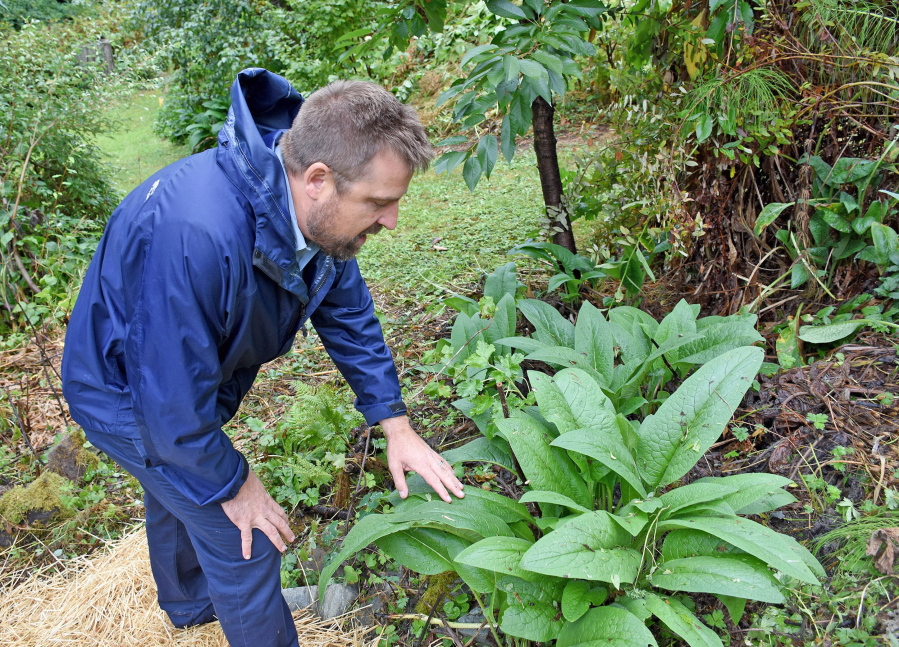MOUNT VERNON — While walking through her property in Alger, Sarai Stevens could gather the fixings for a meal or simply snack along the way, plucking leaves, berries and plums from the branches of trees and bushes throughout her food forest.
Here there are no traditional garden rows, and instead of using artificial fertilizer and watering profusely, plants are strategically placed so that they support one another rather than compete for sun, water and soil nutrients.
This concept is called permaculture — the idea that mimicking nature can produce a lot of food without a lot of effort, the Skagit Valley Herald reported.
“You don’t have to battle back nature in order to get a few things you want to eat,” Stevens’ friend, Will Honea, said while touring the food forest.
Stevens and Honea are members of the recently formed nonprofit Woolley Food Forest Association, which seeks to create a food forest to the Helping Hands Food Bank in Sedro-Woolley.
“Our group’s goal is to demonstrate the way this can work in our ecosystem. It’s beneficial for people and nature,” said Honea, who is one of the association’s board members.
As the Woolley Food Forest Association formed earlier this year with a mission to spread the word about permaculture to others in Skagit County, the food bank sought to relocate and start a community garden at its new site.
Honea said it was a perfect opportunity to form a partnership.
The association will plant and manage the community food forest, which will provide fresh food to food bank customers. The association will also organize workshops to teach food bank customers and volunteers how to manage the forest and harvest the produce.
“Knowing how to do this is super empowering. It’s empowering to grow your own food,” Honea said.
The association hosted its first work party Aug. 28, when volunteers spread pond liner over the 2 acres at the corner of Fruitdale and Wicker roads that will soon become the first community food forest in Skagit County.
Stevens, executive director of the association, said the liner will kill grasses and weeds, preparing the soil for planting in January.
She has designed a food forest that will use a wide variety of edible plants ranging from walnut and peach trees to grapes and mushrooms. It will also include designated areas for spices and medicinal flowers.
Walkways and benches will provide access to the nontraditional community garden, which will be sprinkled with common varieties such as rhubarb, onions, spinach and chives as well as goumi berries, which provide the key nutrient of nitrogen to other plants.
It’s a low-input, high-yield model. Food forests don’t require tilling, seeding, fertilizing, watering and weeding like traditional gardens, and they can produce a variety of nutrient dense foods.
Stevens’ own food forest is flourishing with apple, plum, peach, hazelnut and chestnut trees, and a variety of berries, vegetables, greens, herbs and spices.
“It’s unbelievable the amount of food it can produce in a small area,” Honea said.
He picked and sampled sour leaves from a sedum plant and cucumber-like-flavored flowers from a boarge plant, highlighting how much of the nontraditional garden is edible.
Stevens and Honea are excited to bring these foods to the food bank, characterizing it as a community effort.
It has received support including donations and volunteer labor from several groups and companies in Skagit County and surrounding areas, including the Upper Skagit Indian Tribe, Skagit River Ranch and Janicki Industries.
“It’s turned into this great, positive, community thing,” Honea said.
Stevens’ own food forest also has community ties. She said friends have helped her cultivate it, and shared the fruits of the labor.
Many of her seeds and starts also came from loved ones. The plum tree thriving in its nook was a seedling from her grandmother’s yard; some of the flowering plants were from a friend whose mother brought them from outside the U.S.
“My garden represents a lot of my community, my friends,” Stevens said. “Everything here has a story.”
Before she started building her food forest 11 years ago, only an apple tree and powder-pink rose plant stood in her yard, surrounded by grass. Today, edible bushes are tucked around the base of the apple tree and the pink rosebuds peek out from among berries, greens and herbs that thrive in the Pacific Northwest’s climate.
Once plants are established in a food forest, they can reseed themselves. Beneath the soil a fungal web forms, connecting the roots of the various plants and allowing them to exchange nutrients.
“That’s where all the magic happens,” Stevens said while holding soil laced with some of the white web.
Stevens and Honea said permaculture draws off of indigenous practices and adds scientific knowledge and plants from around the world.
“It’s the marriage of a lot of old, practical stuff combined with more scientific knowledge,” Stevens said.
Stevens said the Woolley Food Forest Association was inspired by the Beacon Food Forest, a 7-acre community permaculture garden planted in Seattle’s Beacon Hill neighborhood in 2009, and Bullock’s Permaculture Homestead that the Bullock family has been growing on Orcas Island for some 34 years.
Others in Skagit County and the surrounding area are using permaculture as well, including Feral Farm Agroforestry in the Rockport area and Shambala Farm on Camano Island.



